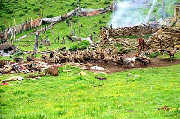| Chinese Way > top |
|
|
Sky Burial in Tibet
Sky burial is to feed vultures with the body of the dead. After vultures finish eating the body and fly into the sky, Tibetans think that the dead will go to the heaven. It is the usual means adopted to dispose of the corpses of commoners, and is not considered suitable for children who are less than 18 years old, pregnant women, or those who have died of infectious disease or accident. Even today, the origin of sky burial remains largely hidden in Tibetan mystery.
Sky burial is a ritual with great religious meaning behind it. Tibetans are encouraged to witness this ritual, to confront death openly and to feel the impermanence of life. Tibetans believe that the corpse is nothing more than an empty vessel. The spirit, or the soul, of the deceased has exited the body to be reincarnated into another circle of life. It is believed that the Drigung Kagyu order of Tibetan Buddhism established the tradition in this land of snow, although there are other versions of its origin. The corpse is offered to the vultures. It is believed that the vultures are
Dakinis. Dakinis are the Tibetan equivalent of angels. In Tibetan, Dakini means
"sky dancer". Dakinis will take the soul into the heaven, which is understood to
be a windy place where souls await reincarnation into their next lives. This
donation of human flesh to the vultures is considered virtuous because it saves
the lives of small animals that the vultures might otherwise capture for food.
Sakyamuni, one of the Buddhas, demonstrated this virtue. To save a pigeon, he
once fed a hawk with his own flesh.
|
||||||
 |

 Religious belief
Religious belief